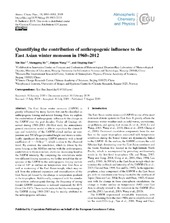Quantifying the contribution of anthropogenic influence to the East Asian winter monsoon in 1960-2012
Peer reviewed, Journal article
Published version

Åpne
Permanent lenke
https://hdl.handle.net/1956/22244Utgivelsesdato
2019-08-07Metadata
Vis full innførselSamlinger
- Geophysical Institute [1198]
Originalversjon
https://doi.org/10.5194/acp-19-9903-2019Sammendrag
The East Asian winter monsoon (EAWM) is greatly influenced by many factors that can be classified as anthropogenic forcing and natural forcing. Here we explore the contribution of anthropogenic influence to the change in the EAWM over the past decades. Under all forcings observed during 1960–2013 (All-Hist run), the atmospheric general circulation model is able to reproduce the climatology and variability of the EAWM-related surface air temperature and 500 hPa geopotential height and shows a statistically significant decreasing EAWM intensity with a trend coefficient of ∼−0.04 yr−1, which is close to the observed trend. By contrast, the simulation, which is driven by the same forcing as the All-Hist run but with the anthropogenic contribution to them removed, shows no decreasing trend in the EAWM intensity. By comparing the simulations under two different forcing scenarios, we further reveal that the responses of the EAWM to the anthropogenic forcing include a rise of 0.6∘ in surface air temperature over East Asia as well as weakening of the East Asian trough, which may result from the poleward expansion and intensification of the East Asian jet forced by the change in temperature gradient in the troposphere. Additionally, compared with the simulation without anthropogenic forcing, the frequency of strong (weak) EAWM occurrence is reduced (increased) by 45 % (from 0 to 10/7). These results indicate that the weakening of the EAWM during 1960–2013 may be mainly attributed to the anthropogenic influence.
